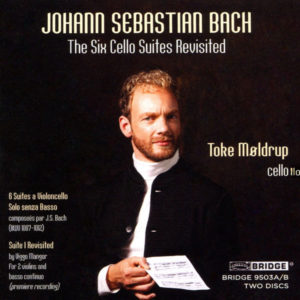
Toke Møldrup. Bach Cello Suites Bridge 9503A/B Released 2017.
Recorded at Hendriksholm Church Copenhagen Denmark. Suites 1-4 2015 Suites 5&6 2017.
On this recording Møldrup plays a David Tecchler cello 1697. Suites 1-5 and a mid 18th century Italian cello rebuilt as a 5 string cello in 2016 by luthier Birger Kulmbach of Copenhagen.
No information about strings or bow provided.
The Cellist.
Toke Møldrup is Danish and is celebrated in his home country by the prestigious award from Queen Ingrid for achievements over his 20 year career just prior to the release of this CD. His former teachers include Morten Zeuthen (also Danish) and Martin Ostertag, both featured on this web site with reviews of their recordings of the Suites.
I suspect Møldrup has a quirky sense of humour if his publicity photos are anything to go by. On the cover of this CD he has presented himself in a mock up of the well known painting of Bach, by Elias Gottlob Haussmann, and on his web site he can be seen playing the cello under water!
This web site is to be commended for making available the full text of this CD’s liner notes. This is particularly important for those who prefer to stream or download music digitally as often the text is not included in the files.
The recording.
This recording is an interesting melding of playing styles. It is not uncommon for performers to play in Baroque style on instruments with a modern set up. The results can often be pleasing with light and rhythmic playing, using minimal vibrato. Møldrup appears to be playing on a cello with modern set up, possibly gut strings but playing in a more traditional full bodied “full fat sound”. However, the rhythmic, articulate and non legato playing of Baroque style are very evident. There is plenty of ornamentation particularly in repeats. I am not aware of vibrato but the captured sound can only be described as big and resonant. The reverberations of the playing in the recording venue are sometimes a little intrusive, but seem to be dampened sufficiently to avoid a muddy sound.
However, the close microphone use does pick up a fair bit of finger board noise.
This CD is much more than a recording, it is a project. The liner notes describe the aims and rationale very well. Included in the CD is a new piece based on the first Suite which seeks to look at Bach’s music in a new light. This is done by dissecting the melody and continuo parts using two violins and cello with organ for the continuo. I find this helps the listener understand more clearly the mastery of Bach who is able to create the illusion of these separate components within the single cello line.
Møldrup’s partner, Viggo Mangor in the project is also his producer and arranger/composer of the “Suite I revisited”.
The music.
On first play through I am impressed by pace, rhythm and momentum of the interpretation. In the notes Møldrup himself talks of “channelling” the music of Bach. He describes the concept of harmonic rhythm, and “yielding to the harmonic pulse dictated by the underlying thoroughbass”. Møldrup goes on to say, “there is little time to complete a technical detail before the next chord sets in”. This makes good sense to me as clumsy ornamentation really disrupts the flow of music. As a consequence of this quest, possibly taken to extreme, there is remarkably little variation of speed and timing in this performance. This is particularly evident in the Allemandes of the last two Suites. Elsewhere, movements where one might expect pauses or breathing spaces just keep on assailing the senses! Also I begin to notice that the dynamics are not hugely varied.
The combination of speed and flowing phrases results in an impression of hastiness. Having said that it is very pleasing to the mind, perhaps less so to the heart. In my opinion, performers such as Diltiens and Valli, are able to dispatch ornamentation with equal aplomb but with more emotional effect.
Two parts one instrument.
Later in the notes Møldrup writes: “it is important to bear in mind the basic composition at all times: melody and thoroughbass”. This is evident in the playing with bass lines very clearly demarcated. A very good example of this is in the third Suite Courante, towards the end of the first section. The playing of the Sarabandes picks out the melody very well. Often the first time around the bass notes are barely played exposing the melody. The repeat then is played with more evident chording.
The final point to make, is that there is a huge amount of improvisational playing by Møldrup. Mostly it is very subtle but quite a few times it is striking and for me hugely enjoyable. There are many interesting modulations particularly in the repeated sections which add considerable interest.
The additional new work “Suite I revisited I find interesting but not stirring, possibly requiring a few more listens but a very welcome effort to demonstrate the majesty of Bach’s creations.
Conclusion.
This is a very distinctive performance of the Suites and certainly one for any listener with more than a passing interest in the Suites. It is very different. Not I suspect to everyone’s taste but certainly one to audition. It is particularly gratifying to have the match between the written ideas and the end audible results.
Charles.